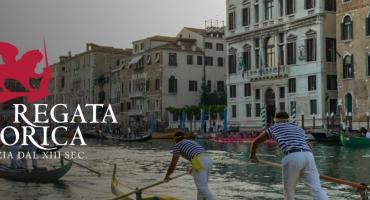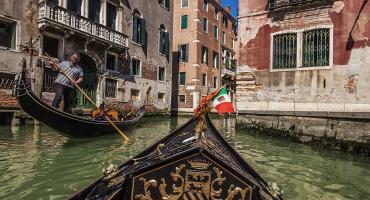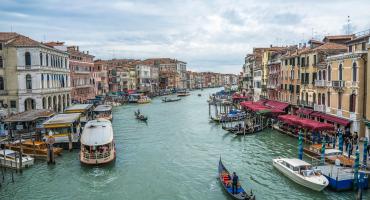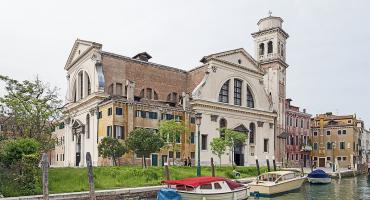The "Gondola" is the oldest and most well-known Venetian boat in the world, now becoming the quintessential tourist symbol of an increasingly attractive Venice. Despite the centuries, the gondola continues to navigate the Venetian canals, ferrying groups of boisterous tourists in search of an unforgettable experience to share...
"Gondola," meaning Ark or Chest from the ancient Greek etymology, perhaps referred to an enclosed, protected space where the few precious belongings of the first inhabitants of the lagoon were kept. Since ancient times, the boat has been the key element on which the life or survival of Venice depended.
The famous Venetian boat also derives from the Latin "Cuncula," meaning shell: it is 11 meters long and weighs 600 kg, yet it can be easily maneuvered with a single oar by the gondolier. Besides its fame due to the charm of the city where it is typically used to navigate different parts of the sestieri, it is studied for its unique construction features that make it a one-of-a-kind vessel in the world.
Every type of boat was built considering the needs imposed by the structure and tortuosity of the canals, coupled with the hazards of shallow waters. The absence of a keel and rudder meant that flat-bottomed boats could be maneuvered using a single oar by the standing boatman at the stern. This characteristic use of the oar belongs to the so-called "Voga alla veneta." This type of rowing is peculiar to all Venetian boats, which boast a unique type of oarlock called "Forcola" in Venetian. The "Forcola" is carved from a quarter of a wooden trunk, usually walnut, about 60 cm in diameter, and has a very complex shape that varies according to the characteristics of the rower’s body and rowing style. It is only by fully exploiting its shape that the gondolier, skillfully maneuvering the oar, can direct the gondola in any direction. All forcole are handmade, working with woods renowned for their elasticity, using tools that only expert craftsmen can handle.
The gondola's structure is asymmetrical, with the left side wider than the right. This asymmetry clearly shifts the boat's center of gravity to the right side, resulting in a rightward tilt, with greater immersion on its right side. Since the boat tends to rotate to the left due to the push of the oar, the rightward tilt counters this tendency. The flat bottom allows it to pass through very shallow waters.
Gondolas are built in “Squeri” or shipyards, where “Maestri d’ascia” (master carpenters) pass down the secrets of woodworking, painting, and decorative carving from generation to generation. They are made from eight different types of precious wood: oak, cherry, larch, lime, walnut, mahogany, and elm. Each type of wood is used to make specific components of the boat, all hand-worked using traditional tools: the axe, plane, saw, and hammer. The curvatures of the planks are naturally obtained by wetting and heating the wood with fire. The boat's aft line is designed considering the weight of the owner, and Venetian feet are still used for measurements, as they are most suitable for the job. The gondola has a curious half-moon shape, as only a small part of its hull rests on the water to reduce friction. It tilts to the right side of the waterline and is kept balanced by the oar on the forcola and the gondolier who skillfully maneuvers it from the opposite side.
The ancient gondolas were equipped with an arched cover called “Felze,” decorated with precious fabrics and carpets. To avoid ostentations of wealth, the magistrates decreed the use of only one type of fabric for the “Felze”: a black woolen cloth called “Rascia.”
All gondolas feature the "Ferro" at the prow, with the characteristic six-toothed comb representing the six sestieri of Venice, and the "Risso" at the stern representing the Giudecca. The distinctive black color comes from an ordinance by the Magistrato alle Pompe aimed at reducing the opulence with which nobles and the wealthy decorated their boats. It is also a general characteristic of all Venetian boats, due to the use of pitch as a waterproofing agent. In 1580, there were about 10,000 gondolas; today, there are no more than 500 in the lagoon.
The “Squeraroli” (boat builders) were part of the School of Arts and Crafts, headquartered near the church of S. Trovaso, where there is still a shipyard today. Currently, only a few shipyards remain active: Tramontin, Coop. Di S. Trovaso, in Dorsoduro, Crea, and Dei Rossi in Giudecca.
In addition to this traditional means of transport, navigation today has modernized and sped up. Although tourists are still fascinated by the gondola and its gentle, undulating movement through the canals of Venice, Venetians use the 'barchino' daily for practicality and speed.
Nowadays, gondolas are used both by enthusiasts of “Voga alla veneta” and as typical Venetian craft objects displayed as works of art. One forcola is even exhibited in New York at the Metropolitan Museum! The makers of forcole are called “Remeri,” and besides these, they also make oars, which the Serenissima continued to demand in large quantities. In Venice, very few continue this traditional craft, among them: F. Furlanetto, S. Pastor, and P. Brandolisio.




